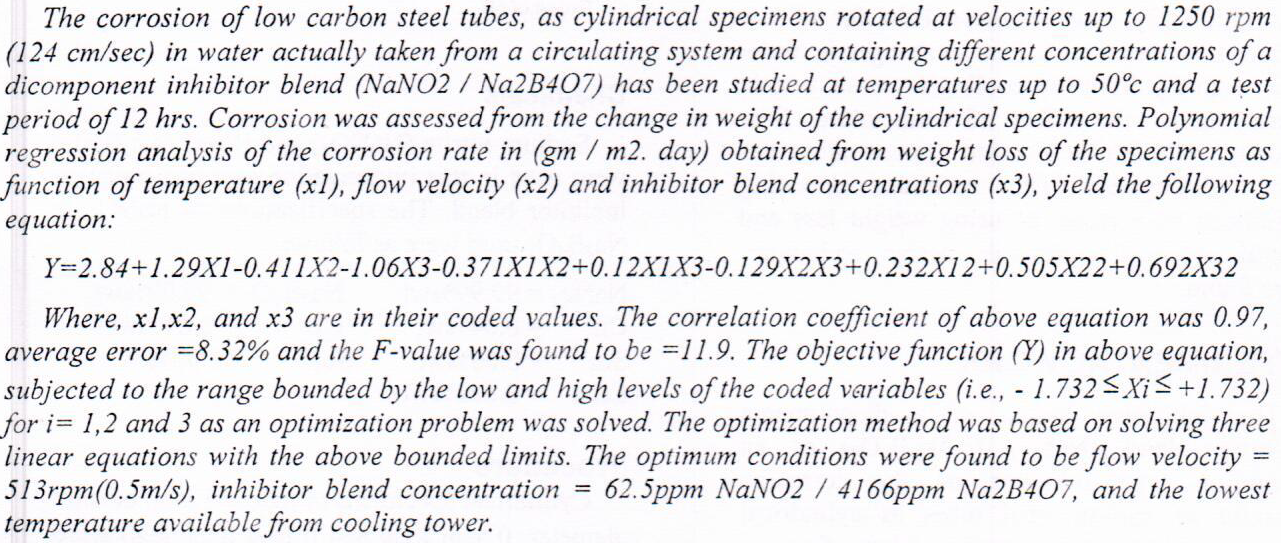
This study offers numerical simulation results using the ABAQUS/CAE version 2019 finite element computer application to examine the performance, and residual strength of eight recycle aggregate RC one-way slabs. Six strengthened by NSM CFRP plates were presented to study the impact of several parameters on their structural behavior. The experimental results of four selected slabs under monotonic load, plus one slab under repeated load, were validated numerically. Then the numerical analysis was extended to different parameters investigation, such as the impact of added CFRP length on ultimate load capacity and load-deflection response and the impact of concrete compressive strength value on the structural performance of
... Show More (1)
(1)
 (165)
(165)
 (106)
(106)
This study shows that it is possible to fabricate and characterize green bimetallic nanoparticles using eco-friendly reduction and a capping agent, which is then used for removing the orange G dye (OG) from an aqueous solution. Characterization techniques such as scanning electron microscopy (SEM), Energy Dispersive Spectroscopy (EDAX), X-Ray diffraction (XRD), and Brunauer-Emmett-Teller (BET) were applied on the resultant bimetallic nanoparticles to ensure the size, and surface area of particles nanoparticles. The results found that the removal efficiency of OG depends on the G‑Fe/Cu‑NPs concentration (0.5-2.0 g.L-1), initial pH (2‑9), OG concentration (10-50 mg.L-1), and temperature (30-50 °C). The batch experiments showed
... Show More (4)
(4)
 (5)
(5)
The δ-mixing of γ-transitions in 70As populated in the 32 70 70 33 ( , ) Ge p n As γ
reaction is
calculated in the present work by using the a2-ratio methods. In one work we applied this method for two cases, the first one is for pure transition and the sacend one is for non pure transition, We take into account the experimental a2-coefficient for previous works and δ -values for one transition only.The results obtained are, in general, in a good agreement within associated errors, with those reported previously , the discrepancies that occur are due to inaccuracies existing in the experimental data of the previous works.
The δ-mixing of γ-transitions in 70As populated in the 32 70 70 33 Ge p n As (, ) γ reaction is calculated in the present work by using the a2-ratio methods. In one work we applied this method for two cases, the first one is for pure transition and the sacend one is for non pure transition, We take into account the experimental a2-coefficient for previous works and δ -values for one transition only.The results obtained are, in general, in a good agreement within associated errors, with those reported previously , the discrepancies that occur are due to inaccuracies existing in the experimental data of the previous works.
Spintronic offers a solution by exploiting spin instead of electron charge since spin current propagation can occur in principle without dissipation. One of the applications involve within this project for storage media is heat-assisted magnetic recording (HAMR). The objective of this study is to simulate the behavior of thermal gradient to generate a pure spin current using an ultrafast femtosecond (fs) laser in a nano-sized multilayered structure of (Al2O3/Ni81Fe19 (Py)/Cu/Y3Fe5O12 (YIG)/Gd3Ga5O12 (GGG)) at room temperature. A ferromagnetic/spacer/magnetic insulator nano-sized multilayered is the proposed structure f
... Show More (1)
(1)
A new compound 2-(4-methoxyphcnyl)-5-(4-aminophenyl)-1,3,4-
oxadiazole (VI) was prepared by intramol ecular condensation reaction followed by elimination of some simple moieties such as IhO and HCI by using POCI3 with acid hydrazide. A series of new ShiffsÂ
bases 2-(4-methoxyphenyl)-5-[4(4:alkoxybenzoyloxy) benzylidene amino phenyl] I,3,4-oxadia:t.ole (VII].was synthesized from treatment
of oxadiazole derivative [VI] with an appropriate aromatic aldehyde
(IU). Struct\lfe of the resulting products have been ascertaim:d by their melting pointS, elemental analysis ( some of them) and spectral data.
